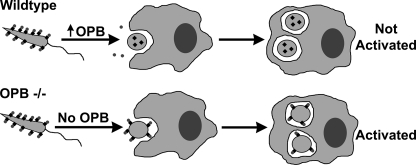FIGURE 10.
Model for OPB function in the Leishmania life cycle. This schematic details the proposed function of Leishmania OPB during infection of a vertebrate host. In a wild type infection, surface enolase (black diamonds) binds host plasminogen (dark gray circles) on the parasite cell surface. As the parasite begins differentiating into an amastigote, OPB is up-regulated, thereby clearing surface enolase and plasminogen. The amastigotes replicate undetected within the macrophage. In an OPB(−/−) infection, when the parasite differentiates into the amastigote stage, enolase and plasminogen are retained on the cell surface. This infection is detected by the macrophage, resulting in increased macrophage gene transcription and reduced parasite virulence.

